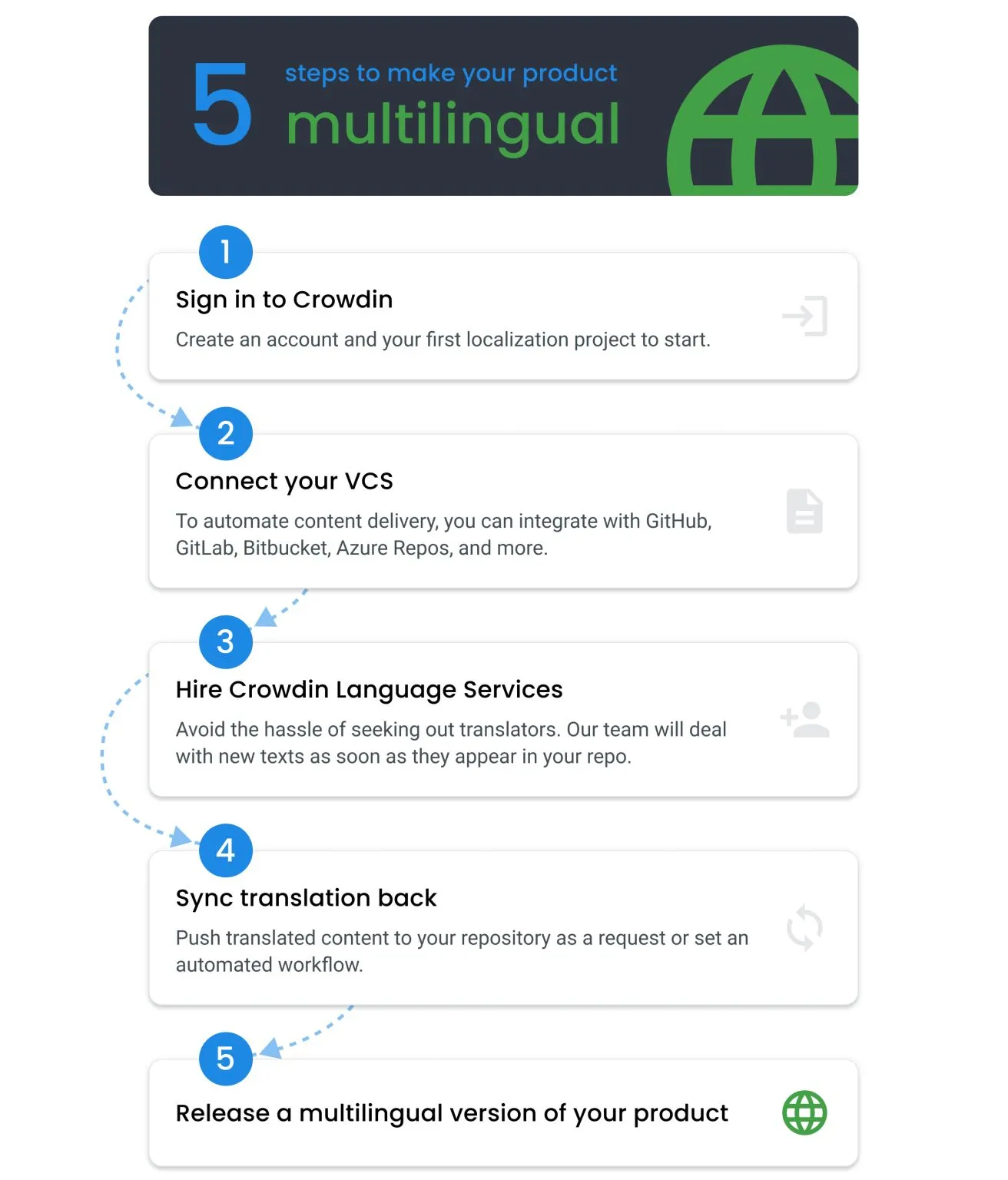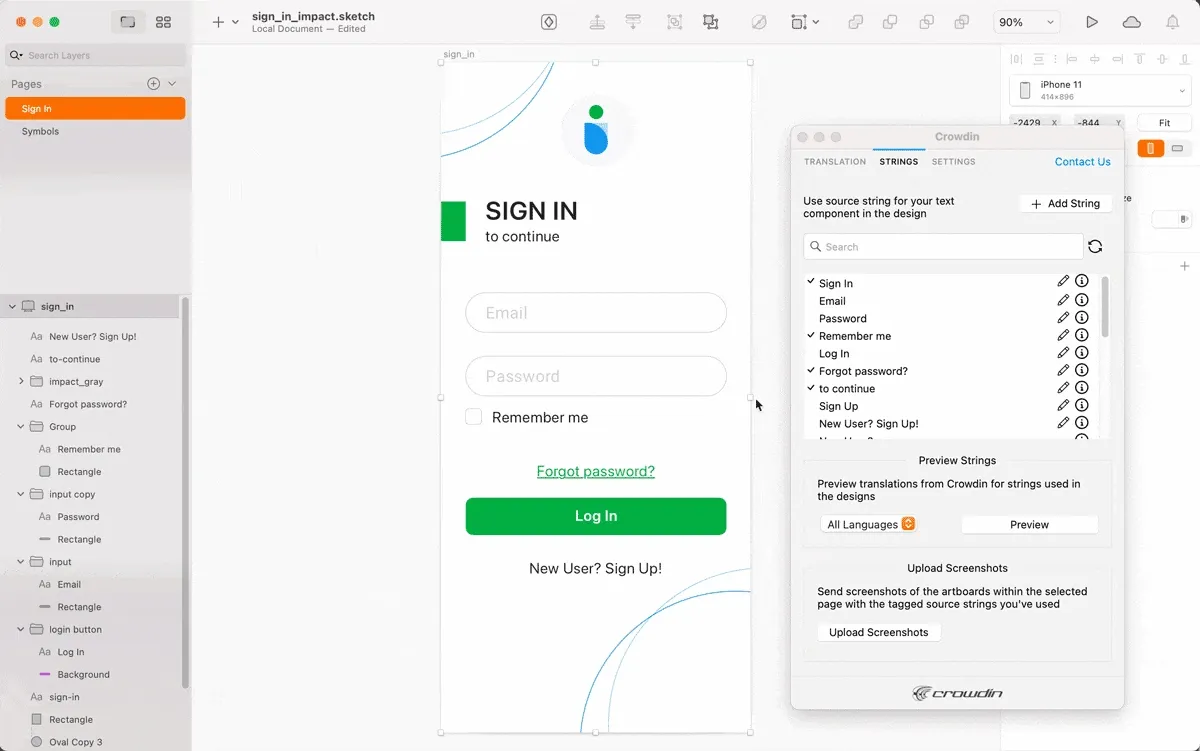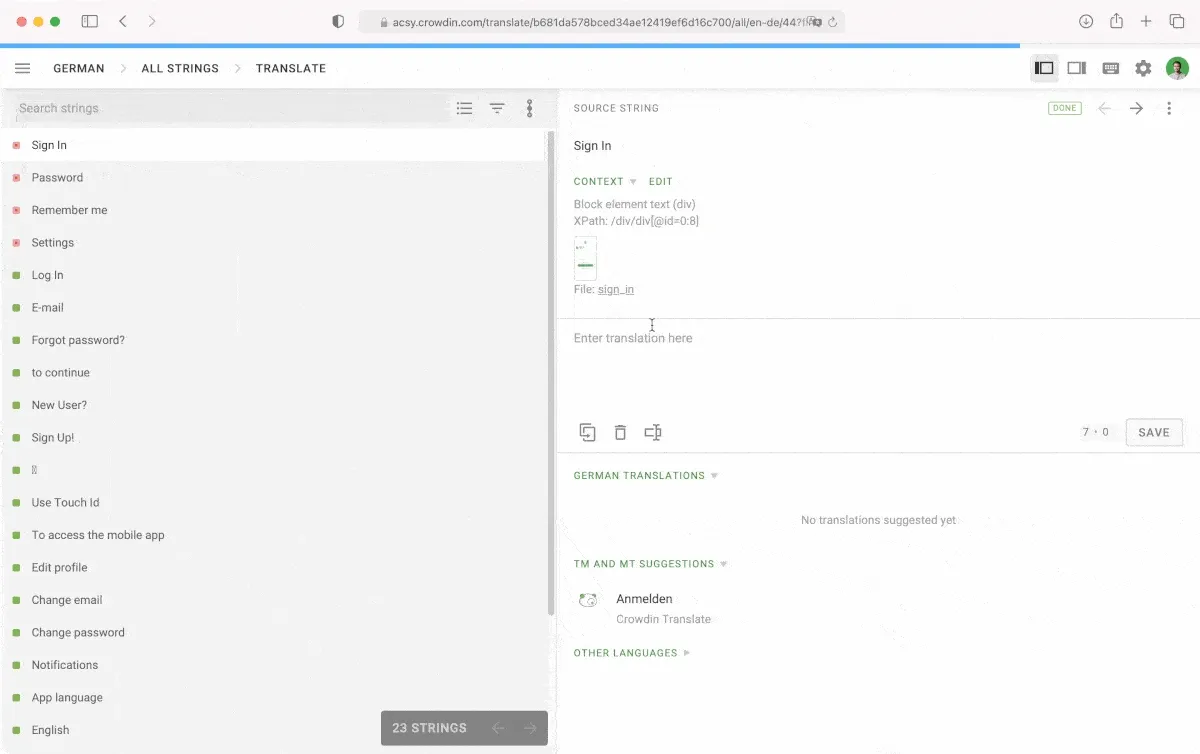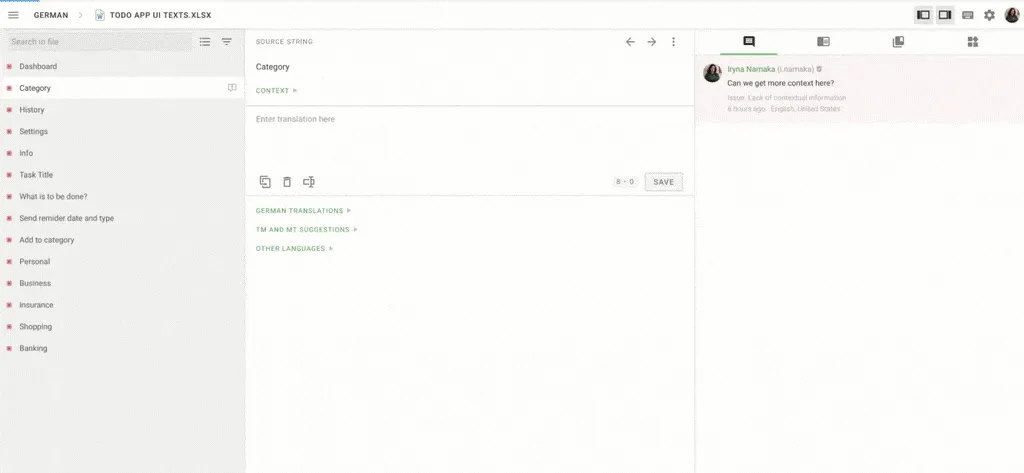Localization used to be a part of the app scaling strategy. But not anymore. Today, when users download a mobile application, they already expect it to match their language preferences. So no matter what stage of the app development you’re in, localization should be part of it. The good news is, that localization is no longer a process that slows down everything. If done with the right technology, it is smoothly integrated into the development process and becomes an integral part of the app life cycle.
Let’s discuss automation in the iOS and Android app localization, sharing translations between app localization projects, and providing context for translators.
Steps Before Localizing Your Mobile Application
To be prepared is half the victory. So, let’s focus on what you need to know and work on before you start localizing your app.
1. Prepare Your Code with Internationalization (i18n)
Internationalization (i18n) means engineering your app so it can be localized. This is the most important technical step, where you need to:
- Move your text out of the code: This means “externalizing” all texts that are user-facing. Instead of writing text in your code, you move it into a separate “resource file”. Translators then can work on your text without any need to touch your code.
An example of web app internationalization in our Next.js i18n guide.
- Design a flexible UI: Your UI should be prepared for texts that expands. For example, German words are often longer. Your layouts need to be prepared to “longer” languages.
Learn 5 best practices for UI localization.
- Work on plurals, dates, and numbers: You can’t just add an “s” for plurals. (What about “1 item” vs.”2 items” vs.”5 items”?). Different regions also write dates and numbers differently (DD/MM/YY vs. MM/DD/YY; 1,000.00 vs. 1.000,00).
Read about how to manage plurals, dates and numbers with the ICU Message Format.
2. Choose the Target Market and Languages
“The more, the merrier” you might think. But at the beginning, your priority should be quality, not quantity. Suppose you are just starting with app localization. In that case, we suggest picking a few languages to begin with. For example, the languages most of your current users speak and some of the most common languages on the internet like English, Spanish, Turkish, and more. This could be your starting point. As your localization project develops, add new languages and even dialects.
3. Choose the Translation Strategy
- Configure the best machine translation and/or LLM for your AI translation.
- Work with an in-house translation team.
- Hire a professional vendor or agency that is deeply familiar with your target language and culture.
Hiring an agency can provide valuable insight to an app localization project, as often, they work with native translators who have the best insights about their culture. Need quick translations from professionals? Go with Crowdin Language Service.

4. Use a Safe and Secure Localization Platform
The Crowdin team have built a localization platform that can help your product reach a new audience and be sure that your data is safe. Security is an important component of what we do. Crowdin is SO/IEC 27001 Certified, ensures compliance with the GDPR, offers a SAML Single Sign-On (SSO) feature, and more. To discover more about data security, see the page.
Continuous Localization Is What You Need
If you’re new to the topic, the best idea to start with is that localization is an integral part of product development, the same as prototyping or testing. So localization will require some additional setups at the beginning to ensure continuous workflow later on.
If you’re in the middle of the mobile app localization process, you, probably, already understand that simply downloading resource files, sending them to translators, and integrating translations into the codebase is easier said than done. First, it’s a total waste of time with all the manual work. Secondly, with even the slightest change in the source texts or when a new copy arrives, you need to repeat the process of downloading, sending, and integrating all over. Finally, when you send a spreadsheet with strings to translators without any context, be ready to receive myriads of lack-of-context-related questions that are multiplied by the number of target languages.
How to Automate Content Synchronization?
There are a variety of continuous integrations you can set up with Crowdin, and they all do a great job of synchronizing content between the systems you use. There are integrations with GitHub, GitLab, Bitbucket, and Azure Repos. Integration with GitHub Actions is supported as well. You can also use the Crowdin CLI or Android Studio plugin to automatically get source files uploaded to Crowdin and integrate translations into the codebase effortlessly.
How to Speed Up Apps Localization?
Developers fear mobile app localization because it can slow down even the most speedy teams. From our experience, localization does slow down the development when the localization of a feature starts after its release in the source variant. In other words, when translators can access content only after the deployment.
With Crowdin, you can configure different branches for each app version in your Crowdin project, then test and release multilingual versions of your app right away.
Check out the case study and learn how Aviasales, a tech company that develops travel software, managed to localize apps in the agile environment.
A Key Feature: Over-the-Air Updates
To update content within a mobile application, you need to roll out a new version on the App Store or Google Play. The process seems straightforward, and waiting for the app verification doesn’t cause much trouble if the updates happen occasionally. But when you manage a multilingual app with constant updates in 20 languages, for example, rolling new versions each time new translations arrive is not an option.
To make translations available for users much faster, we recommend using Over-the-Air technology. Create a distribution in your Crowdin project and install Crowdin SDK on the mobile app (Android or iOS). Distribution is a CDN vault that mirrors the translated content of your project. You can create separate distributions for different files or one distribution per project.
After you’re done with the settings, each time you’d like to update translations in your app, you can create a release within the required distribution and get translations in front of your users in minutes.
Learn more about Crowdin Over-the-Air Content Delivery for Android and iOS apps.
Alternative: Localization without Resource Files
Traditionally, app localization starts when the resource files are handed off to translators, either by email (we cry typing that in) or automatically. In other words, first comes the resource file, and then you can proceed with localization.
How about we reverse this workflow a bit and send strings for translation directly from your design tool (like Figma, Sketch, or Adobe XD)? Localization without resource files is a new approach we offer the design and development teams that collaborate on UI translations in Crowdin.
With it, designers working on the prototypes in Adobe XD, Figma, or Sketch send strings for translation with the keys and text segmentation rules.

Because each string has its unique identifier, development teams then can integrate both source and translated content in the codebase effortlessly.
Besides, if the source files in Crowdin will be of other formats than Android XML and Strings, engineers will also be able to launch custom exporters we’ve mentioned earlier and download files in the necessary format. They can use either Crowdin API or crowdin download targets command of the CLI 3.4.0 version and higher.
For designers, the integration between Crowdin and their design tools is a great opportunity to preview translated mockups, customize them if necessary, or notify engineers on the elements that should scale.

Learn more about Crowdin plugins for design teams.
Localize your app with Crowdin
Managing Both Android and iOS Apps in One Project
Usually, iOS and Android app versions have much of the same content. In Crowdin, you can easily detect duplicate strings and not translate the same content twice.
You can translate your Android and iOS mobile apps within the same project and hide similar strings, so translators don’t have to translate the same strings twice. Or you can choose to localize either the Android or iOS app first, and then download translations in the corresponding format, such as Android XML or Strings.
How to Hide Duplicate Translation Strings to Save Costs
When configuring the project settings, enable the Hide duplicates option, and similar strings will be shown only once for translators. The duplicated strings will get the translation of the master string automatically. In this case, a master string is the one that was added to the project first.
Unifying Placeholders for iOS and Android Strings
To treat more strings as duplicates, you can unify placeholders within iOS and Android strings used in the same project. For example, Hello, %s! (Android) and Hello, %@! (iOS) will be matched as duplicates and will be shown to translators as Hello, [%s]! On export, you’ll get files with the placeholders in their original formatting.
Learn how to unify placeholders in Android and iOS localization.
What if I Want Two Separate Projects?
It’s also an option. In this case, to save translation costs, you can reuse the Android version’s translations in the iOS project or vice versa. For this, enable Translation Memory (TM) Sharing in the Project Settings. You then can pre-translate content with the Translation Memories you have or allow translators to use TM suggestions while translating.
How to Export Files in Different Formats
You can also translate your Android app in Crowdin without uploading the resource files for the iOS and then launch a custom exporter via Crowdin API or CLI to get the source and translated files in the Strings formats. Or vice versa, translate the iOS app and export the translation in the Android XML format.
You can export strings in the Android XML and Strings formats regardless of the initial source file format, including CSV, DOCX, XLSX, and more.
Localize your app with Crowdin
Context for Translators – the More, the Better
Of course, the quality of translation depends on the proficiency of the translation team, either in-house or the one you hire. Yet, even the best of the translators might interpret the sources wrongly if no background information is available.
Providing context should not become an overlooked step when you set up a localization project. Crowdin offers you a variety of options on how to give context for translation.
Screenshots with Tagged Strings
In Crowdin, translators work in the online Editor. Along with fields for the source and translated content, there is also a field with the context added from the comments to each string in the codebase.
Besides, if a string was tagged on any of the screenshots you’ve uploaded, the screenshot will be shown right under the source string. Learn more about using screenshots in application localization.

Integration with Appetize.io
You can use the Appetize.io emulator not only to test your app but also to provide context for your translation team. To enable integration, install the Crowdin app for Appetize. It will let translators run your app directly in the Editor and see strings in action. The app will help you take screenshots of the app quickly as well. Applicable for both Android and iOS app localization.

Using a Project Glossary
To explain product-specific terms, you can create a project Glossary. You can also get it translated (with the help of the Translate Glossary app, for example).
Once you have glossary terms translated, we also recommend enabling QA check for Consistent Terminology. This way, Crowdin will notify translators every time a term is translated improperly and suggest the preferred variant. Learn more about Glossary.
Real-Time Preview and Crowdin SDK
When you set up Crowdin Mobile SDK, you can also configure two additional features – Screenshots and Real-Time Preview.
- To quickly add app screenshots to the Crowdin project, configure the Screenshots feature and get the necessary app version installed on your device. Then open the app, sign in to your Crowdin account, and click through the app interface, taking screenshots where necessary. The images will be automatically added to your Crowdin project with all the strings tagged.

- With the Real-Time Preview feature configured, translators will work on source strings in Crowdin Editor and get the app preview either on the app emulator or their devices. The string in the app will change in real time as translators start typing in the translation.

Learn more about providing context with Crowdin Mobile SDK.
Localize your app with Crowdin
What’s Next: App Store Optimization (ASO) and App Localization
Like the app localization, optimizing its store description can boost your downloads. That’s why we’re going to talk about ASO and localization. To begin with, ASO stands for app store optimization and is influential in improving an app’s rank and discoverability in any app store (Google Play Store, Apple App Store, Samsung Galaxy Apps, Huawei App Store, and more). A higher ranking in an app store’s search results makes your app more visible to potential users.
Let’s get more organic downloads for your app. What aspects do we recommend you optimize for your app’s success?
Research and Localize Your Keywords
The first one is to research and use the relevant keywords. Take the time to find and analyze your competitors and relevant keywords to evaluate which ones are right for your product and market. You can use both free and paid services for research.
Examples of the tools with keyword research capabilities are:
- Ahrefs
- SE Ranking
- Data.ai
- Ranktracker
Optimize Your App’s Title and Description
Research which keywords will help raise the visibility of your app and use them in your app title and descriptions.
The documentation of stores does offer very clear information regarding:
- Character limits
- Use of keywords
- Requirements for videos and screenshots
Crowdin, for example, has an article about localizing App Store. Android also has guidelines for creating custom store listings to target specific countries.
Localize Your App’s Visuals (Screenshots, Videos)
The design part we mentioned above, like the app icon, video, and screenshots, is also important. Users will pay more attention to an app description that shows the app UI or even a video showing the main features. Working together with each department and combining efforts with your design teams, you can create compelling visuals for every culture and language you target.
You can localize UI and translate marketing visuals efficiently with the Crowdin plugins for Figma, Sketch, and Adobe XD. View the list of apps for design teams.

Localize Measurements, Dates, and Currencies
Many apps include units of measurement. Whether it’s a cooking app tracking receipts, a running app monitoring users’ progress, or a money app recording spending. Adding and displaying the measurements according to the locale is extremely important.
You’ll need to localize your app for each metric system since certain countries prefer one over the other. Don’t forget that while numbers may appear universal, weights and measures and even date and time formats are not. To improve your ASO and maximize your downloads, you need to ensure that all of these are displayed in local units.
Localize and Manage App Reviews
You can raise your app’s rating by getting positive reviews and feedback.
The App Store, for example, takes reviews into account when adjusting its ranking, which means that having positive reviews will improve your visibility on both Android and iOS.
Typically, people won’t bother downloading your app if the reviews are bad or few. How do you get reviews?
-
Make sure that you consider your user experience at all times.
-
No one wants to be bothered with popups once they download an app. Try not to send these kinds of notifications to new users.
-
Ask for a review a few weeks after the user downloaded your app.
-
You can also encourage users with some in-app bonuses after leaving a review.
Moving into a new market takes a lot of work. However, localizing and optimizing your mobile app will help you attract new customers and grow your revenue. Don’t forget to track the correct mobile app metrics before and after the ASO to understand which activities helped the most.
You Know the Tricks Now
We’ve discussed all the aspects you should consider when you start customizing your app for each target market. To sum up, there are two common misbeliefs to avoid. Assuming that everyone will use your app in English is the first one. And that you can handle localization without technology would be the second.
Crowdin is designed to automate localization, help you release multilingual versions of your app, and meet the expectations of your global users. To get started, register a Crowdin or Crowdin Enterprise account. If you like to learn more about best practices and discuss the peculiar workflows you have, book a personal demo with our tech manager.
Watch the on-demand webinar on app localization
FAQ
What is mobile app localization?
Mobile app localization - application adaptation to the target market language and culture. App localization includes:
- text translation,
- graphics modification,
- layouts adjustments,
- compliance with target market’s regulations and cultural preferences.
Why is mobile app localization important?
Mobile app localization is must-have for the most mobile applications because it allows apps to reach more users. Additionally it makes your app more accessible and relevant to the users in your target market.
App localization enhances user experience, it can also greatly improve download rates and user retention.
How does the mobile app localization process work?
The mobile app localization process involves the following steps:
- Choosing the set of languages to translate the app to.
- Choosing the translation strategy.
- Based on the strategy, connecting source strings to the translation machine of choice (could be machine/AI translation, your in-house translation team or external vendor/agency).
- Translation and localization process.
- Visuals localization and layout corrections.
- Testing the app for functionality and usability in the new languages.
- Launching the localized app versions.
Iryna Namaka
Iryna Namaka has vast experience in content creation for different spheres and different tech products. She loves to create a clear and consistent brand voice for products that are used globally.
